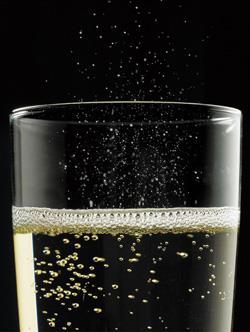Bubbles erupting from the surface of sparkling wines carry a complex mixture of flavour molecules into the air above the glass
The bubbles that fountain from a glass of champagne ferry a complex array of flavour molecules into the air above the glass, lifting the aroma towards you as you take a sip - and the molecular profile of this aerosol blend is very different to that of the bulk liquid, say European scientists.

G?rard Liger-Belair from the University of Reims, France, and Philippe Schmitt-Kopplin from the German Research Centre for Environmental Health, Munich, have used ultrahigh-resolution mass spectrometry to unravel the chemical makeup of droplets fired into the air by bubbles bursting on the surface of sparkling wines. ’The fine chemistry of these tiny droplets is not the same as the champagne bulk,’ says Liger-Belair. ’The droplets have much higher concentrations of surface active molecules, and some of these are recognised aroma and flavour compounds.’
Liger-Belair notes that it is not entirely surprising to find higher concentrations of surfactant-like molecules in the aerosol droplets, since the air-water interface of a bubble is a favourable place for such molecules to dip their water-soluble ’head’ parts into the wine, while keeping their hydrophobic ’feet’ dry in the bubble of air. ’The big surprise for me was that we found lots of flavour molecules.’
The method the team used was remarkably simple: ’We collected the aerosol by putting a microscope slide over the champagne glass,’ says Liger-Belair. They then simply rinsed the slides with methanol and transferred that solution to their spectrometer. The profile of components from the droplets was compared with diluted samples taken directly from the bulk wine. ’[We found that] some components were over-concentrated by a factor of 30 [in the droplets compared to the bulk], but it depends very much on the individual molecules,’ he adds.
’The chemistry of champagne and other sparkling wines is hugely complex - there are hundreds of components,’ Liger-Belair points out, so identifying them was quite a challenge. The team compared peaks in their mass spectra with compounds known to contribute to the flavour of other wine varieties and found a multitude of esters, fatty acids, monoterpene alcohols and other molecules, many involved in aroma and flavour. ’But we found many other masses in our spectra that have not been attributed to specific compounds yet - we have plenty left to unravel.’
Michael Qian from the food science and technology department at Oregon State University, US, says that much wine research is currently looking at what compounds are important for varietal aromas of wines, with some looking more at the viticulture side - how to impact flavour compounds and precursors in wine grapes. ’But this study is different,’ he says, ’it’s looking more from a flavour release point of view - trying to see what exactly is happening when we drink the wine, which is very difficult to do.’
Liger-Belair hopes to collaborate with experts in wine chemistry to work out which of the molecules they’ve identified are most important in the taste of sparkling wines. ’We’re just at the beginning of the story now - we have unravelled a phenomenon and hopefully we will be able to find many more important compounds.’
Phillip Broadwith
References
G Liger-Belair et alProc. Natl. Acad. Sci. USA, 2009, DOI:10.1073/pnas.0906483106






No comments yet